中国石油大学(华东)本科毕业设计(论文)参考模板(2017)
- 格式:doc
- 大小:122.50 KB
- 文档页数:14
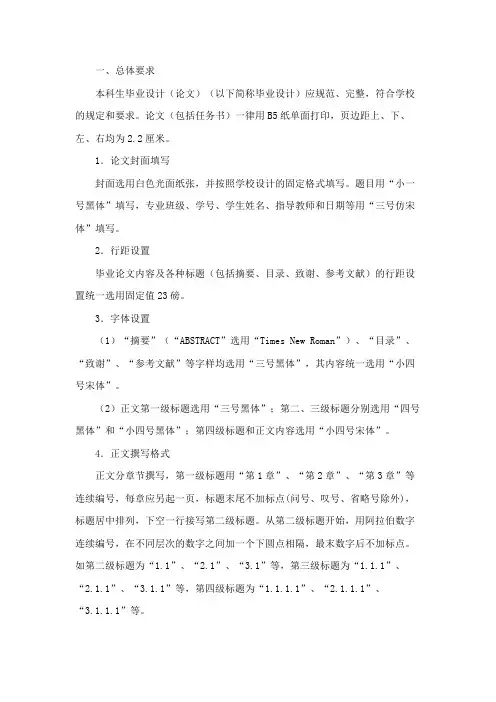
一、总体要求本科生毕业设计(论文)(以下简称毕业设计)应规范、完整,符合学校的规定和要求。
论文(包括任务书)一律用B5纸单面打印,页边距上、下、左、右均为2.2厘米。
1.论文封面填写封面选用白色光面纸张,并按照学校设计的固定格式填写。
题目用“小一号黑体”填写,专业班级、学号、学生姓名、指导教师和日期等用“三号仿宋体”填写。
2.行距设置毕业论文内容及各种标题(包括摘要、目录、致谢、参考文献)的行距设置统一选用固定值23磅。
3.字体设置(1)“摘要”(“ABSTRACT”选用“Times New Roman”)、“目录”、“致谢”、“参考文献”等字样均选用“三号黑体”,其内容统一选用“小四号宋体”。
(2)正文第一级标题选用“三号黑体”;第二、三级标题分别选用“四号黑体”和“小四号黑体”;第四级标题和正文内容选用“小四号宋体”。
4.正文撰写格式正文分章节撰写,第一级标题用“第1章”、“第2章”、“第3章”等连续编号,每章应另起一页,标题末尾不加标点(问号、叹号、省略号除外),标题居中排列,下空一行接写第二级标题。
从第二级标题开始,用阿拉伯数字连续编号,在不同层次的数字之间加一个下圆点相隔,最末数字后不加标点。
如第二级标题为“1.1”、“2.1”、“3.1”等,第三级标题为“1.1.1”、“2.1.1”、“3.1.1”等,第四级标题为“1.1.1.1”、“2.1.1.1”、“3.1.1.1”等。
正文中的标题一般不超过四级,标题层次要清晰,第二至第四级标题均单独占一行,且靠左端书写,第二级标题序数前不留空格,第三、四级标题序数前要空两个汉字位置。
各级标题序数后均空一格接写标题。
5.论文字数毕业论文一般使用汉语简化文字书写,不少于10000汉字。
6.文献查阅学生查阅与毕业设计相关的文献(不含教科书)不少于10篇,其中外文文献应不少于2篇。
7.外文翻译外文翻译字数不少于5000汉字。
译文封面格式(可参考论文封面格式)各学院要统一,用B5纸单面打印。
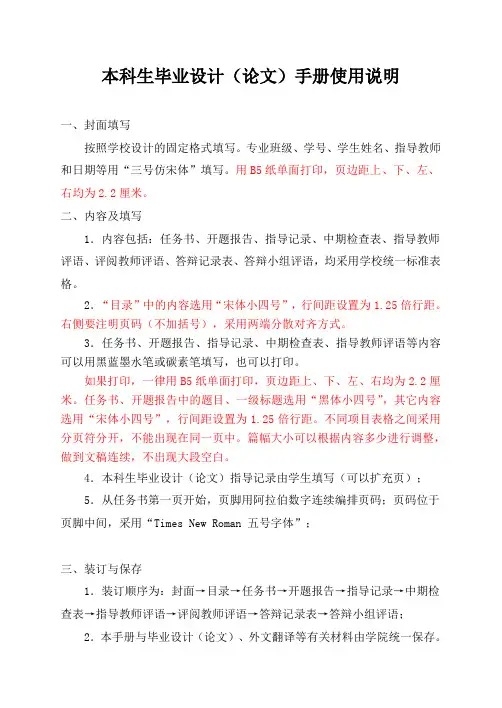
本科生毕业设计(论文)手册使用说明一、封面填写按照学校设计的固定格式填写。
专业班级、学号、学生姓名、指导教师和日期等用“三号仿宋体”填写。
用B5纸单面打印,页边距上、下、左、右均为2.2厘米。
二、内容及填写1.内容包括:任务书、开题报告、指导记录、中期检查表、指导教师评语、评阅教师评语、答辩记录表、答辩小组评语,均采用学校统一标准表格。
2.“目录”中的内容选用“宋体小四号”,行间距设置为1.25倍行距。
右侧要注明页码(不加括号),采用两端分散对齐方式。
3.任务书、开题报告、指导记录、中期检查表、指导教师评语等内容可以用黑蓝墨水笔或碳素笔填写,也可以打印。
如果打印,一律用B5纸单面打印,页边距上、下、左、右均为2.2厘米。
任务书、开题报告中的题目、一级标题选用“黑体小四号”,其它内容选用“宋体小四号”,行间距设置为1.25倍行距。
不同项目表格之间采用分页符分开,不能出现在同一页中。
篇幅大小可以根据内容多少进行调整,做到文稿连续,不出现大段空白。
4.本科生毕业设计(论文)指导记录由学生填写(可以扩充页);5.从任务书第一页开始,页脚用阿拉伯数字连续编排页码;页码位于页脚中间,采用“Times New Roman 五号字体”;三、装订与保存1.装订顺序为:封面→目录→任务书→开题报告→指导记录→中期检查表→指导教师评语→评阅教师评语→答辩记录表→答辩小组评语;2.本手册与毕业设计(论文)、外文翻译等有关材料由学院统一保存。
四、其他1.开题报告的内容一般包括课题研究的目的、主要内容、技术路线等;2.本手册作为校、院毕业设计(论文)工作检查的重要依据。
中国石油大学(华东)本科生毕业设计( 论文 )手册学生姓名: 学 号:专业班级:石油工程2003-1班 指导教师:开始日期:2007年04月09日 完成日期:2007年06月20日目录任务书………………………………………………………………………页码开题报告……………………………………………………………………页码指导记录……………………………………………………………………页码中期检查表…………………………………………………………………页码指导教师评语………………………………………………………………页码评阅教师评语………………………………………………………………页码答辩记录表…………………………………………………………………页码答辩小组评语………………………………………………………………页码成绩汇总表…………………………………………………………………页码本科生毕业设计(论文)任务书学生(签名):指导教师(签名):系主任(签名):年月日本科生毕业设计(论文)指导记录学生(签名):指导教师(签名):年月日年月日本科生毕业设计(论文)中期检查表本科生毕业设计(论文)指导教师评语本科生毕业设计(论文)评阅教师评语本科生毕业设计(论文)答辩记录表本科生毕业设计(论文)答辩小组评语注:总成绩中平时表现占20%、毕业论文占40%(指导教师和评阅教师评分各占20%)、论文答辩占40%。
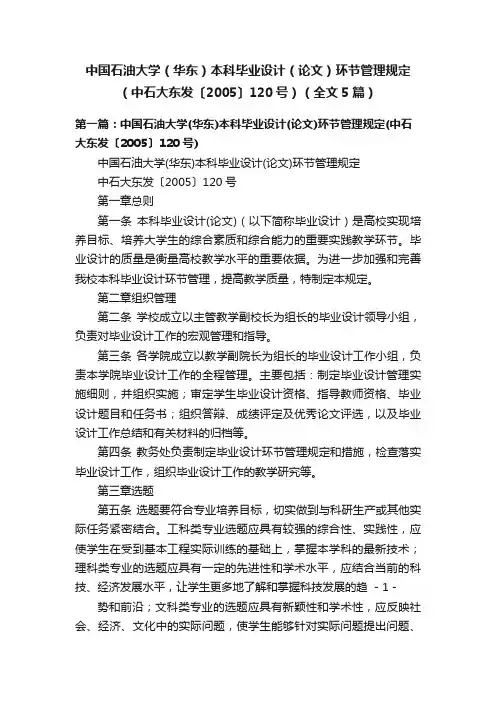
中国石油大学(华东)本科毕业设计(论文)环节管理规定(中石大东发〔2005〕120号)(全文5篇)第一篇:中国石油大学(华东)本科毕业设计(论文)环节管理规定(中石大东发〔2005〕120号)中国石油大学(华东)本科毕业设计(论文)环节管理规定中石大东发〔2005〕120号第一章总则第一条本科毕业设计(论文)(以下简称毕业设计)是高校实现培养目标、培养大学生的综合素质和综合能力的重要实践教学环节。
毕业设计的质量是衡量高校教学水平的重要依据。
为进一步加强和完善我校本科毕业设计环节管理,提高教学质量,特制定本规定。
第二章组织管理第二条学校成立以主管教学副校长为组长的毕业设计领导小组,负责对毕业设计工作的宏观管理和指导。
第三条各学院成立以教学副院长为组长的毕业设计工作小组,负责本学院毕业设计工作的全程管理。
主要包括:制定毕业设计管理实施细则,并组织实施;审定学生毕业设计资格、指导教师资格、毕业设计题目和任务书;组织答辩、成绩评定及优秀论文评选,以及毕业设计工作总结和有关材料的归档等。
第四条教务处负责制定毕业设计环节管理规定和措施,检查落实毕业设计工作,组织毕业设计工作的教学研究等。
第三章选题第五条选题要符合专业培养目标,切实做到与科研生产或其他实际任务紧密结合。
工科类专业选题应具有较强的综合性、实践性,应使学生在受到基本工程实际训练的基础上,掌握本学科的最新技术;理科类专业的选题应具有一定的先进性和学术水平,应结合当前的科技、经济发展水平,让学生更多地了解和掌握科技发展的趋-1-势和前沿;文科类专业的选题应具有新颖性和学术性,应反映社会、经济、文化中的实际问题,使学生能够针对实际问题提出问题、分析问题,并提出解决问题的方案和自己的观点等。
第六条原则上一个学生一个题目。
对于需要多人合作完成的题目,对每个学生要有明确的分工要求。
第七条题目的难度和工作量要适当。
对于有些研究时间确实较长的题目,可以提前申报,让学生利用课余时间提前介入。
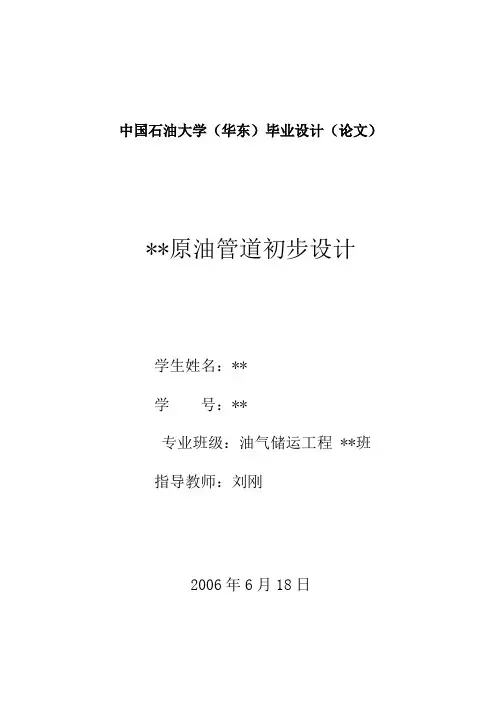
中国石油大学(华东)毕业设计(论文)**原油管道初步设计学生姓名:**学号:**专业班级:油气储运工程 **班指导教师:***2006年6月18日摘要**管线工程全长865km,年设计最大输量为506万吨,最小输量为303.6万吨,生产期14年。
管线沿程地形较为起伏,最大高差为346.8m,经校核全线无翻越点;在较大输量时可热力越站,较小输量时可压力越站。
输油管采用沥青加强级外保护的防腐措施。
全线共设热泵站12座,管线埋地铺设。
管材采用 406.4×8.0,X65的直弧电阻焊钢管;采用加热密闭式输送流程,先炉后泵的工艺,充分利用设备,全线输油主泵和给油泵均采用并联方式。
加热炉采用直接加热的方法。
管线上设有压力保护系统,出站处设有泄压装置,防止水击等现象,压力过大造成的危害。
首站流程包括收油、存储、正输、清管、站内循环、来油计量及反输等功能;中间站流程包括正输、反输、越站、收发清管球等功能。
采用SCADA 检测系统,集中检测、管理,提高操作的安全性和效率。
由计算分析证明该管线的运行可收到良好的效益并有一定的抗风险能力。
关键词:管型;输量;热泵站;工艺流程ABSTRACTThe design of ** pipeline engineering for oil transportation is complete on June 2006.The whole length of the pipeline is 865 kilometer and the terrain is plan.The maximum of transport capacity is 506 million ton per year and minimum of throughout is 303.6 million ton per year.The choice of main equipment and determination of station site are based on the condition of every throughout. After the technical evaluation , one type of steel pipeline called X65 is select. The optimum diameter is 404.6 millimeter and the wall thicket is 8.0 millimeter. The maximum pressure of operating for design is 450MP.In order to reduce the loss of heat, the pipeline is buried under the ground. The pipeline is coated with 7-millimeter thick anti-corrosion asphalt layer and impressed current catholic protection to protect the pipe from corrosion.The process of transportation is pump-to-pump tight line operation. Crude oil is heated at first and the pump in each station. There are three 220D-65×10pumps are equipped as the transporting pump. The process of flows in the station includes: collecting crude oil; forward transportation; reverse pumping over station and circulation in the station.Along the main line, oil transportation included head station, intermediate heating and pumping station, and terminal station.Through the benefit analysis and feasibility study of operation,the project has a good economic benefit and the design is feasible.Keywords :pipeline corrosion ;pump-to-pump station ;analysis目录前言 (1)第一章工艺计算说明书 (1)1.1 设计原始数据 (1)1.2 基础计算及经济管径的选取 (3)1.3 热力计算 (5)1.4 水力计算 (8)1.5 反输计算 (11)1.6 输油工艺及主要设备选型 (12)第二章工艺设计计算书 (16)2.1 基础计算 (16)2.2 工况计算 (19)2.3 设备选型 (26)2.4 开泵方案 (30)2.5 反输计算 (37)结论 (41)致谢 (42)参考文献 (43)前言“输油管道初步设计”是石油储运专业毕业设计内容之一。
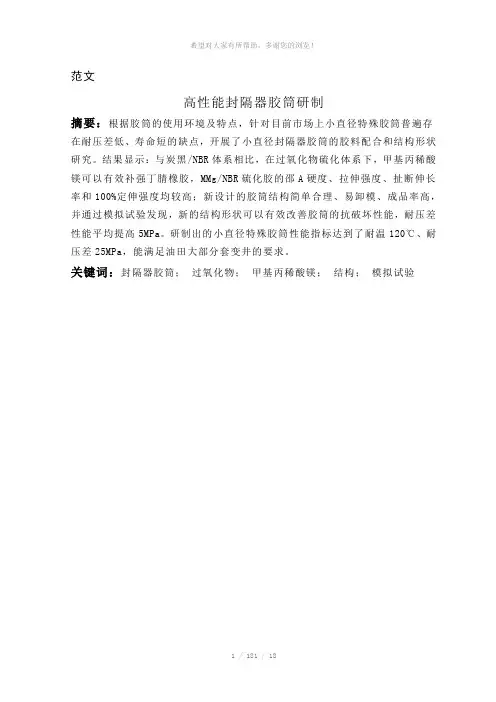
范文高性能封隔器胶筒研制摘要:根据胶筒的使用环境及特点,针对目前市场上小直径特殊胶筒普遍存在耐压差低、寿命短的缺点,开展了小直径封隔器胶筒的胶料配合和结构形状研究。
结果显示:与炭黑/NBR体系相比,在过氧化物硫化体系下,甲基丙稀酸镁可以有效补强丁腈橡胶,MMg/NBR硫化胶的邵A硬度、拉伸强度、扯断伸长率和100%定伸强度均较高;新设计的胶筒结构简单合理、易卸模、成品率高,并通过模拟试验发现,新的结构形状可以有效改善胶筒的抗破坏性能,耐压差性能平均提高5MPa。
研制出的小直径特殊胶筒性能指标达到了耐温120℃、耐压差25MPa,能满足油田大部分套变井的要求。
关键词:封隔器胶筒;过氧化物;甲基丙稀酸镁;结构;模拟试验目录前言 (1)1 封隔器胶筒工况分析 (2)1.1简介 (2)1.2工况分析 (2)1.3胶筒性能的影响因素 (2)2 研究方案设计 (4)2.1技术路线 (4)2.2技术方案 (4)3 配方实验 (5)3.1实验准备 (5)3.1.1 原材料选择 (5)3.1.2 仪器设备 (5)3.2实验方案 (5)3.2.1 补强性能采用正交设计法进行配方设计 (5)3.2.2 防老化试验设计 (5)3.3实验过程 (6)3.3.1 混炼 (6)3.3.2 硫化 (6)3.3.3 物化性能测试 (6)3.4结果分析 (7)3.4.1 补强性能分析 (7)3.4.2 防老化性能分析 (7)3.5小结 (7)4 结构形状优化 (8)4.1尺寸设计 (8)4.2端部形状设计 (8)5 加工工艺研究 (9)5.1填料方式 (9)5.2胶筒壁厚对硫化时间及温度的影响 (9)6 封隔器胶筒模拟试验 (10)6.1试验设备 (10)6.2试验记录 (10)6.3试验结果分析 (10)6.3.1 结构形状对胶筒性能的影响 (10)6.3.2 初始密封的座封力测定 (11)6.3.3 座封载荷和密封压差的关系 (11)结论 (12)参考文献 (13)致谢 (14)前言近年来,中原油田的开发已进入高含水阶段,井况恶化现象严重,各种新的配套工艺措施不断出现,所需井下工具的结构类型也越来越多。
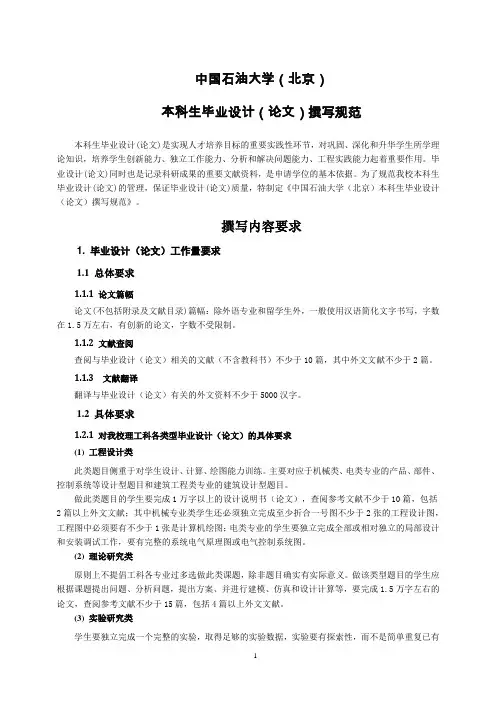
中国石油大学(北京)本科生毕业设计(论文)撰写规范本科生毕业设计(论文)是实现人才培养目标的重要实践性环节,对巩固、深化和升华学生所学理论知识,培养学生创新能力、独立工作能力、分析和解决问题能力、工程实践能力起着重要作用。
毕业设计(论文)同时也是记录科研成果的重要文献资料,是申请学位的基本依据。
为了规范我校本科生毕业设计(论文)的管理,保证毕业设计(论文)质量,特制定《中国石油大学(北京)本科生毕业设计(论文)撰写规范》。
撰写内容要求1. 毕业设计(论文)工作量要求1.1 总体要求1.1.1 论文篇幅论文(不包括附录及文献目录)篇幅:除外语专业和留学生外,一般使用汉语简化文字书写,字数在1.5万左右,有创新的论文,字数不受限制。
1.1.2 文献查阅查阅与毕业设计(论文)相关的文献(不含教科书)不少于10篇,其中外文文献不少于2篇。
1.1.3 文献翻译翻译与毕业设计(论文)有关的外文资料不少于5000汉字。
1.2 具体要求1.2.1 对我校理工科各类型毕业设计(论文)的具体要求(1) 工程设计类此类题目侧重于对学生设计、计算、绘图能力训练。
主要对应于机械类、电类专业的产品、部件、控制系统等设计型题目和建筑工程类专业的建筑设计型题目。
做此类题目的学生要完成1万字以上的设计说明书(论文),查阅参考文献不少于10篇,包括2篇以上外文文献;其中机械专业类学生还必须独立完成至少折合一号图不少于2张的工程设计图,工程图中必须要有不少于1张是计算机绘图;电类专业的学生要独立完成全部或相对独立的局部设计和安装调试工作,要有完整的系统电气原理图或电气控制系统图。
(2) 理论研究类原则上不提倡工科各专业过多选做此类课题,除非题目确实有实际意义。
做该类型题目的学生应根据课题提出问题、分析问题,提出方案、并进行建模、仿真和设计计算等,要完成1.5万字左右的论文,查阅参考文献不少于15篇,包括4篇以上外文文献。
(3) 实验研究类学生要独立完成一个完整的实验,取得足够的实验数据,实验要有探索性,而不是简单重复已有的工作;要完成1万字以上的论文,其中包括文献综述、实验部分的讨论与结论等内容,查阅参考文献不少于10篇,包括2篇以上外文文献。
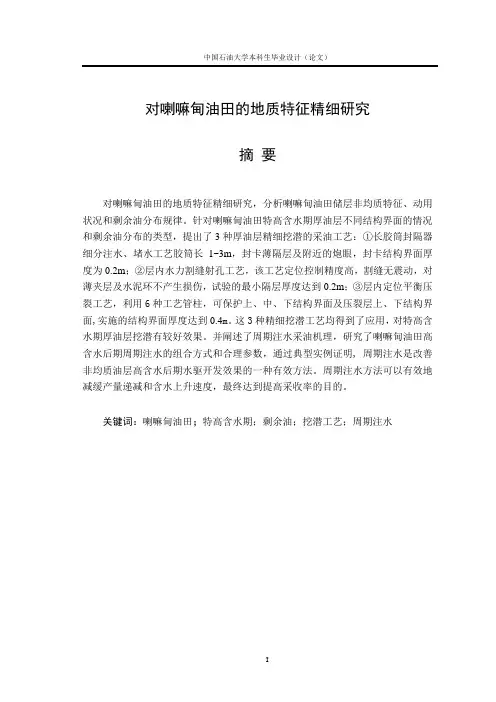
对喇嘛甸油田的地质特征精细研究摘要对喇嘛甸油田的地质特征精细研究,分析喇嘛甸油田储层非均质特征、动用状况和剩余油分布规律。
针对喇嘛甸油田特高含水期厚油层不同结构界面的情况和剩余油分布的类型,提出了3种厚油层精细挖潜的采油工艺:①长胶筒封隔器细分注水、堵水工艺胶筒长1~3m,封卡薄隔层及附近的炮眼,封卡结构界面厚度为0.2m;②层内水力割缝射孔工艺,该工艺定位控制精度高,割缝无震动,对薄夹层及水泥环不产生损伤,试验的最小隔层厚度达到0.2m;③层内定位平衡压裂工艺,利用6种工艺管柱,可保护上、中、下结构界面及压裂层上、下结构界面,实施的结构界面厚度达到0.4m。
这3种精细挖潜工艺均得到了应用,对特高含水期厚油层挖潜有较好效果。
并阐述了周期注水采油机理,研究了喇嘛甸油田高含水后期周期注水的组合方式和合理参数,通过典型实例证明, 周期注水是改善非均质油层高含水后期水驱开发效果的一种有效方法。
周期注水方法可以有效地减缓产量递减和含水上升速度,最终达到提高采收率的目的。
关键词:喇嘛甸油田;特高含水期;剩余油;挖潜工艺;周期注水AbstractLamadian field of the geological characteristics through fine reservoir description, analysis Lamadian reservoir heterogeneity characteristics, status and use of the remaining oil distribution .On the view of different construction interface and different type of remaining oil distribution in thick formations of extra-high water cut period in Lamadian Oilfield, three kinds of fine inner potential excavation technology for thick oil formation were presented. The first one is the fine division water injection and plugging in a long rubber packer with a seal length of1~3meters. This packer can be used to jam the thin barrier and neighbour borehole. The thickness of construction interface jammed by this packer is0.2meter.The second one is the inner hydraulic slotting perforation technology. This technology is characterized by high accuracy for positional control and no quaking for slotting .The operation of this technology has no damage to the thin interbed and cement sheath. The barrier thickness is minimized to0.2meter.The third one is the inner positional balance fracturing technology. Six kinds of string can be used to protect the construction interface. The construction interface of0.4meter in thickness was tested. The three kinds of fine potential excavation technology were all used in large scale and became the new mode for inner potential excavation of the thick formation in the extra-high water cut period. This paper illustrates the mechanism of oil production by cyclic waterflooding and studies the combination method and reasonable parameters of waterflooding in the late stage of high water cut of Lamadian Oil Field. Typical examples prove that cyclic waterflooding is an effective method to improve waterflooding development in late stage of high water cut in heterogeneous reservoirs. Cycle injection can be effective in slowing production decline and increase in speed aquifers, and ultimately achieving the objective of enhanced oil recovery.Key words:Lamadian Oilfield; extra-high water cut period; remaining oil; technology of potential tapping;water cycle目录第1章喇嘛甸油田地质特征 (1)1.1喇嘛甸油田基本概况 (1)1.2喇嘛甸油田构造、断层特征…………………………………………... .11.3喇嘛甸油田储层特点和流体性质 (2)1.4喇嘛甸油田油藏类型、油气水分布 (4)第2章喇嘛甸油田储层动用状况及剩余油分布 (5)2.1喇嘛甸油田储层动用状况 (5)2.2喇嘛甸油田的潜力分析 (5)2.3喇嘛甸油田厚油层内剩余油分布 (6)2.4喇嘛甸油田层内剩余油分布模式 (10)第3章喇嘛甸油田特高含水期开发特点、挖潜工艺 (13)3.1喇嘛甸油田特高含水期开发的特点 (13)3.2喇嘛甸油田特高含水期层内剩余油挖潜工艺 (15)3.3喇嘛甸油田特高含水期开发的油井地层压力界限和流压界限 (20)3.4喇嘛甸油田特高含水期开发对钻井、地面流程工艺技术要求 (22)第4章利用周期注水方法改善喇嘛甸油田高含水后期开发效果 (24)4.1周期注水采油机理及数值模拟研究 (24)4.2喇嘛甸油田周期注水效果分析 (26)结论 (27)参考文献 (28)致谢 (31)第1章喇嘛甸油田地质特征喇嘛甸油田基本概况喇嘛甸油田位于黑龙江省大庆市,地形较为平坦,为草原覆盖区,地面海拔高度为145~152m。
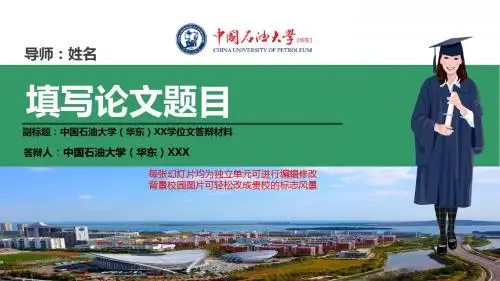
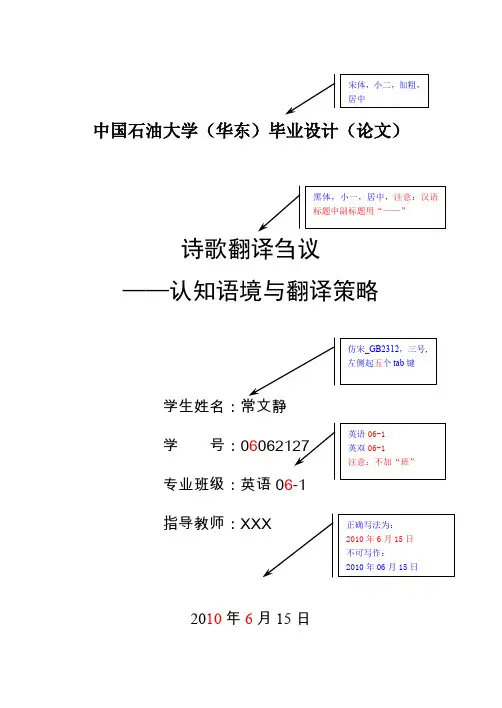
中国石油大学(华东)毕业设计(论文)诗歌翻译刍议 ——认知语境与翻译策略学生姓名:常文静学 号:06专业班级:英语0指导教师:2010年6月15日Translation : Cognitive Context andTranslation StrategytoSchool of Foreign Studiesin Partial Fulfillment of the Requirement for the Bachelor's Degree of Arts in EnglishDongying June 15th , 2010诗歌翻译刍议——认知语境与翻译策略摘 要在这篇论文中,我们介绍了D.Sperber和D.Wilson 的关联理论及由之衍生出来的关联翻译理论,着重阐明了译文读者的认知语境及最佳关联问题。
强语境文化与弱语境文化间的文化缺省导致了译文读者与原文作者间的语境差异,并由此致使作者意图不能有效传递,即未达到最佳关联。
为了解决诗歌翻译中的此类问题,在尽量不损害原诗语境效果的前提下,我们认为译者应试图采用加注、意译等策略,以期弥补文化图式的缺省,达到译文读者A Tentative Study on Poetry Translation: Cognitive Context and TranslationWe introduced the relevance theory proposed by D. Sperber and D. Wilson and the relevance translation theory deriving from it in this paper, andwefocus on the cognitive context of version reader and optimal relevance. The cultural default between high context culture and low context culture causes the differences between version reader and original writer, and then impedes thetranslationof writer’s intention…Key Words: context; cultural default; optimal relevance;poetry translationIntroduction ………………………………………………………….1 Chapter One The First Step of the Journey: A Panoramic Survey of..33…..4 ....5 6 2.1 6 and..6 2.1.2 6 (7)2.2.1.................7 2.2.2. (8)Conclusion .......................32 Bibliography .. (34) (38)IntroductionA Tentative Study of Poetry Translation:Strategy IntroductionThe relevance theoryproposedby D.Sperber and D.Wilson in their book Relevance: Communication and Cognition contributed greatly to the cognitive pragmatic study. It is not a translation theory but it can effectively explain and direct translation activity. Wilson’sstudent E.A.Gutt published his Dr. PaperTranslation and Relevance: Cognition and Context in 1991, in which he proposed the relevance translation theory, which has become the most important new theoryThe First Step of the Journey: A Panoramic Survey of Relevance TheoryIn 1986, D. Sperber and D. Wilson developed a cognitive approach to the interpretation of human communication. In their book Relevance: Communication and Cognition , they studied three aspects of the traditional objects in pragmatic research: (a) how the process of human interpretation is achieved. (b) the importance of context in comprehension. And (c) the rejection of the notion of mutual knowledge and the proposal of an mutually manifest assumptions relevance and the Cognitive Principle of Relevance.1.3 Principles in Relevance Theory1.3.1 Cognitive PrincipleContextChapter Two Context2.1 ContextDifferent from the commonly accepted assumption that the context for the comprehension of an utterance is given before hand,Sperberand Wilson (92) propose a much more dynamic view of context. A context is a construct that has to be established and developed in the course of interaction in order to select the correct interpretation. The determination of context is seen as a matter of choice and as part of the interpretation process itself. A context is a psychological construct, a subset of the hearer’s assumptions about the world.2.2 Contextual Effects2.2.1 Essence and Application of Mutual Knowledge and MutualConcrete Strategy in Poetry Translationpoetry. Chinese and English poetry both have their ownrhythms.However, sometimes it is very difficult for translators to present the same rhythm and form for version readers again. So we have to focus on the whole poem and try to present the inner spirit of it again. …4.1 Faithfulness and Overt Translation…For the sake of analysis and interpretation, we will cite thefollowing poem as an instance:By chance you ’re born from grasses of decay, Dare you fly near where shines the light of day?4.2 Hypotaxis…4.3 Semantic Translation and AnnotationConclusionConclusionThe purpose of this thesis has been to examine some of the basic assumptions and to apply the theory to an interpretation of poetry. The essential purpose of this thesis is an attempt to find the optimal relevance in poetry. In poetry, the intention to produce specific contextual effects in version reader ’s cognitive environment turns out to be a significant factor in the creation of the whole poem. Thus a writer lacking an accurate estimate of the contextual environment of a typical member of the target readers will have problems in attaining effective communication of desired message.Relevance theory is such a type of economics of communication theory and defines a possible point of equilibrium between efforts and effect. Optimal relevance is said to be achieved at the point where maximum yield of information is attained with minimum effort. A type of dynamic equilibrium can be attained at the point of optimal relevance in poetic language, where maximum yield of contextual implication is achieved with an acceptable amount of effort …BibliographyRelevance:Cognition andand LiteraryStyle: An’s The Inheritors[A]. S. Chatman, ed. Literary Style: A Symposium [C]. Oxford: Oxford University. Press, 1971: 45-47. (专著、论文集内文章;注意:若只有一名编者,编者的名和姓后用逗号,加“ed.”(表示editor)。
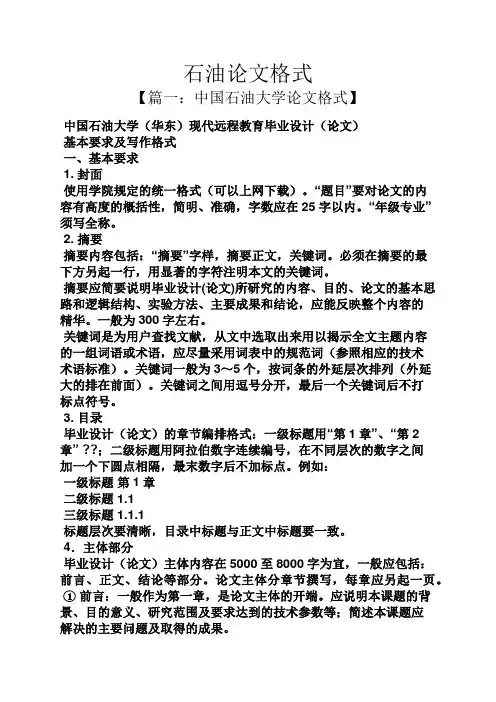
石油论文格式【篇一:中国石油大学论文格式】中国石油大学(华东)现代远程教育毕业设计(论文)基本要求及写作格式一、基本要求1. 封面使用学院规定的统一格式(可以上网下载)。
“题目”要对论文的内容有高度的概括性,简明、准确,字数应在25字以内。
“年级专业”须写全称。
2. 摘要摘要内容包括:“摘要”字样,摘要正文,关键词。
必须在摘要的最下方另起一行,用显著的字符注明本文的关键词。
摘要应简要说明毕业设计(论文)所研究的内容、目的、论文的基本思路和逻辑结构、实验方法、主要成果和结论,应能反映整个内容的精华。
一般为300字左右。
关键词是为用户查找文献,从文中选取出来用以揭示全文主题内容的一组词语或术语,应尽量采用词表中的规范词(参照相应的技术术语标准)。
关键词一般为3~5个,按词条的外延层次排列(外延大的排在前面)。
关键词之间用逗号分开,最后一个关键词后不打标点符号。
3. 目录毕业设计(论文)的章节编排格式:一级标题用“第1章”、“第2章” ??;二级标题用阿拉伯数字连续编号,在不同层次的数字之间加一个下圆点相隔,最末数字后不加标点。
例如:一级标题第1章二级标题 1.1三级标题 1.1.1标题层次要清晰,目录中标题与正文中标题要一致。
4.主体部分毕业设计(论文)主体内容在5000至8000字为宜,一般应包括:前言、正文、结论等部分。
论文主体分章节撰写,每章应另起一页。
①前言:一般作为第一章,是论文主体的开端。
应说明本课题的背景、目的意义、研究范围及要求达到的技术参数等;简述本课题应解决的主要问题及取得的成果。
②论文正文:是作者对研究工作的详细表述,它占全文的绝大部分。
论文主体要符合一般学术论文的写作规范,具备学术性、科学性和一定的创造性。
论文应文字流畅,语言准确,层次清晰,论点清楚,论据准确,论证完整、严密,有独立的观点和见解。
毕业设计(论文)内容要理论联系实际,涉及到他人的观点、统计数据或计算公式的要标明出处,涉及到的计算数据要求准确。
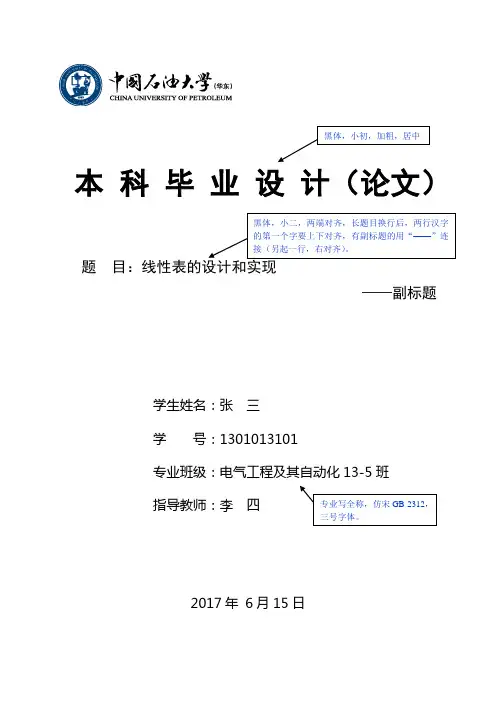
本 科 毕 业 设 计(论文)题 ——副标题学生姓名:张 三 学 号:1301013101专业班级:电气工程及其自动化13-5班 指导教师:李 四2017年 6月15日——副标题要数据结构算法设计和演示(C++)树和查找是在面向对象思想和技术的指导下,采用面向对象的编程语言(C++)和面向对象的编程工具(Borland C++ Builder 6.0)开发出来的小型应用程序。
它的功能主要是将数据结构中链表、栈、队列、树、查找、图和排序部分的典型算法和数据结构用面向对象的方法封装成类,并通过类的对外接口和对象之间的消息传递来实现这些算法,同时利用C++ Builder 6.0中丰富的控件资源和系统解、辅助教学和自我学习的作用。
关键词:The design and implementation of the linear form——副标题Abstract外文摘要要求用英文书写,内容应与“中文摘要”对应。
使用第三人称。
“Abstract” 字体:Times New Roman,居中,三号,加粗,1.5倍行距,段前、段后0.5行间距,勾选网格对齐选项。
“Abstract”上方是论文的英文题目,字体:Times New Roman,居中,小二,加粗,1.5倍行距,间距:段前、段后0.5行间距,勾选网格对齐选项。
Abstract正文选用设置成每段落首行缩进2字符,字体:Times New Roman,字号:小四,1.5倍行距,间距:间距:段前后0.5行间距,勾选网格对齐选项。
Keywords与Abstract之间空一行,首行缩进2字符。
Keywords与中文“关键词”一致,加粗。
词间用分号间隔,末尾不加标点,3-5个,Times New Roman,小四。
如需换行,则新行与第一个关键词首字母对齐。
Keywords:Write Criterion;Typeset Format;Graduation Project (Thesis)目 录第1章 引言 ............................................................................................................................ 1 第2章 线性表的基本理论知识 .. (2)2.1 线性表的定义 .............................................................................................................. 2 2.2 线性顺序表 (2)2.2.1 三级标题名 ........................................................................................................ 2 2.2.2 三级标题名 ........................................................................................................ 2 2.3 线性链表...................................................................................................................... 2 第3章 设计的主体内容 .. (3)3.1 系统结构的设计 .......................................................................................................... 3 3.2 交互界面的设计和实现 .............................................................................................. 3 3.3 线性表的00P 序设计 .. (3)3.3.1 线性表的顺序存储的实现 ................................................................................ 3 3.3.2 线性表的链表存储的实现 .. (4)第4章 结果分析与讨论 ........................................................................................................ 5 第5章 结论 ............................................................................................................................ 7 致 谢 ........................................................................................................................................ 8 参考文献 .................................................................................................................................... 9 附 录 .. (10)附录A 名词术语及缩略词第1章计算机与网络技术的高速发展,特别是面向对象技术的出现,使得C++的软件开发得到了迅速普及。
中国石油大学(华东)毕业设计(论文)诗歌翻译刍议 ——认知语境与翻译策略学生姓名:常文静学 号:06专业班级:英语0指导教师:2010年6月15日Translation : Cognitive Context andTranslation StrategytoSchool of Foreign Studiesin Partial Fulfillment of the Requirement for the Bachelor's Degree of Arts in EnglishDongying June 15th , 2010诗歌翻译刍议——认知语境与翻译策略摘 要在这篇论文中,我们介绍了D.Sperber和D.Wilson 的关联理论及由之衍生出来的关联翻译理论,着重阐明了译文读者的认知语境及最佳关联问题。
强语境文化与弱语境文化间的文化缺省导致了译文读者与原文作者间的语境差异,并由此致使作者意图不能有效传递,即未达到最佳关联。
为了解决诗歌翻译中的此类问题,在尽量不损害原诗语境效果的前提下,我们认为译者应试图采用加注、意译等策略,以期弥补文化图式的缺省,达到译文读者A Tentative Study on Poetry Translation: Cognitive Context and TranslationWe introduced the relevance theory proposed by D. Sperber and D. Wilson and the relevance translation theory deriving from it in this paper, andwefocus on the cognitive context of version reader and optimal relevance. The cultural default between high context culture and low context culture causes the differences between version reader and original writer, and then impedes thetranslationof writer’s intention…Key Words: context; cultural default; optimal relevance;poetry translationIntroduction ………………………………………………………….1 Chapter One The First Step of the Journey: A Panoramic Survey of..33…..4 ....5 6 2.1 6 and..6 2.1.2 6 (7)2.2.1.................7 2.2.2. (8)Conclusion .......................32 Bibliography .. (34) (38)IntroductionA Tentative Study of Poetry Translation:Strategy IntroductionThe relevance theoryproposedby D.Sperber and D.Wilson in their book Relevance: Communication and Cognition contributed greatly to the cognitive pragmatic study. It is not a translation theory but it can effectively explain and direct translation activity. Wilson’sstudent E.A.Gutt published his Dr. PaperTranslation and Relevance: Cognition and Context in 1991, in which he proposed the relevance translation theory, which has become the most important new theoryThe First Step of the Journey: A Panoramic Survey of Relevance TheoryIn 1986, D. Sperber and D. Wilson developed a cognitive approach to the interpretation of human communication. In their book Relevance: Communication and Cognition , they studied three aspects of the traditional objects in pragmatic research: (a) how the process of human interpretation is achieved. (b) the importance of context in comprehension. And (c) the rejection of the notion of mutual knowledge and the proposal of an mutually manifest assumptions relevance and the Cognitive Principle of Relevance.1.3 Principles in Relevance Theory1.3.1 Cognitive PrincipleContextChapter Two Context2.1 ContextDifferent from the commonly accepted assumption that the context for the comprehension of an utterance is given before hand,Sperberand Wilson (92) propose a much more dynamic view of context. A context is a construct that has to be established and developed in the course of interaction in order to select the correct interpretation. The determination of context is seen as a matter of choice and as part of the interpretation process itself. A context is a psychological construct, a subset of the hearer’s assumptions about the world.2.2 Contextual Effects2.2.1 Essence and Application of Mutual Knowledge and MutualConcrete Strategy in Poetry Translationpoetry. Chinese and English poetry both have their ownrhythms.However, sometimes it is very difficult for translators to present the same rhythm and form for version readers again. So we have to focus on the whole poem and try to present the inner spirit of it again. …4.1 Faithfulness and Overt Translation…For the sake of analysis and interpretation, we will cite thefollowing poem as an instance:By chance you ’re born from grasses of decay, Dare you fly near where shines the light of day?4.2 Hypotaxis…4.3 Semantic Translation and AnnotationConclusionConclusionThe purpose of this thesis has been to examine some of the basic assumptions and to apply the theory to an interpretation of poetry. The essential purpose of this thesis is an attempt to find the optimal relevance in poetry. In poetry, the intention to produce specific contextual effects in version reader ’s cognitive environment turns out to be a significant factor in the creation of the whole poem. Thus a writer lacking an accurate estimate of the contextual environment of a typical member of the target readers will have problems in attaining effective communication of desired message.Relevance theory is such a type of economics of communication theory and defines a possible point of equilibrium between efforts and effect. Optimal relevance is said to be achieved at the point where maximum yield of information is attained with minimum effort. A type of dynamic equilibrium can be attained at the point of optimal relevance in poetic language, where maximum yield of contextual implication is achieved with an acceptable amount of effort …BibliographyRelevance:Cognition andand LiteraryStyle: An’s The Inheritors[A]. S. Chatman, ed. Literary Style: A Symposium [C]. Oxford: Oxford University. Press, 1971: 45-47. (专著、论文集内文章;注意:若只有一名编者,编者的名和姓后用逗号,加“ed.”(表示editor)。
一、总体要求本科生毕业设计(论文)(以下简称毕业设计)应规范、完整,符合学校的规定和要求。
论文(包括任务书)一律用B5纸单面打印,页边距上、下、左、右均为2.2厘米。
1.论文封面填写封面选用白色光面纸张,并按照学校设计的固定格式填写。
题目用“小一号黑体”填写,专业班级、学号、学生姓名、指导教师和日期等用“三号仿宋体”填写。
2.行距设置毕业论文内容及各种标题(包括摘要、目录、致谢、参考文献)的行距设置统一选用固定值23磅。
3.字体设置(1)“摘要”(“ABSTRACT”选用“Times New Roman”)、“目录”、“致谢”、“参考文献”等字样均选用“三号黑体”,其内容统一选用“小四号宋体”。
(2)正文第一级标题选用“三号黑体”;第二、三级标题分别选用“四号黑体”和“小四号黑体”;第四级标题和正文内容选用“小四号宋体”。
4.正文撰写格式正文分章节撰写,第一级标题用“第1章”、“第2章”、“第3章”等连续编号,每章应另起一页,标题末尾不加标点(问号、叹号、省略号除外),标题居中排列,下空一行接写第二级标题。
从第二级标题开始,用阿拉伯数字连续编号,在不同层次的数字之间加一个下圆点相隔,最末数字后不加标点。
如第二级标题为“1.1”、“2.1”、“3.1”等,第三级标题为“1.1.1”、“2.1.1”、“3.1.1”等,第四级标题为“1.1.1.1”、“2.1.1.1”、“3.1.1.1”等。
正文中的标题一般不超过四级,标题层次要清晰,第二至第四级标题均单独占一行,且靠左端书写,第二级标题序数前不留空格,第三、四级标题序数前要空两个汉字位置。
各级标题序数后均空一格接写标题。
5.论文字数毕业论文一般使用汉语简化文字书写,不少于10000汉字。
6.文献查阅学生查阅与毕业设计相关的文献(不含教科书)不少于10篇,其中外文文献应不少于2篇。
7.外文翻译外文翻译字数不少于5000汉字。
译文封面格式(可参考论文封面格式)各学院要统一,用B5纸单面打印。
中国石油大学(华东)现代远程教育毕业设计(论文)题目:深******************************** 学习中心:胜利学习中心滨南教学点年级专业:08春网络石油工程学生姓名:#####学号:08########## 指导教师:######职称:######## 导师单位: ###########################中国石油大学(华东)远程与继续教育学院论文完成时间:2010 年02 月25 日中国石油大学(华东)现代远程教育毕业设计(论文)任务书发给学员#### 1.设计(论文)题目:超稠油开发技术研究2.学生完成设计(论文)期限:2009 年08月15 日至2010 年02 月23 日3.设计(论文)课题要求:完成以下研究内容:(1)达到降低(2)通过对开采认识的逐步积累4.实验(上机、调研)部分要求内容:(1)广泛(2)针对(3)针对5.文献查阅要求:(1)要求资料(2)要求数据来源6.发出日期:2008 年08 月15 日7.学员完成日期:2010 年02 月25 日指导教师签名:##学生签名:##中国石油大学(华东)现代远程教育指导教师:#### 职称:### 工作单位:##### 对函授(网络)2008春级专生本层次石油工程专业学员##### 所完成毕业设计(论文)的评语该学员通过自己的实际工作,学员通过自己的实际工作,学员通过自己的实际工作,学员通过自己的实际工作,学员通过自己的实际工作,学员通过自己的实际工作,学员通过自己的实际工作,学员通过自己的实际工作,学员通过自己的实际工作,学员通过自己的实际工作,学员通过自己的实际工作,学员通过自己的实学员通过自己的实际工作,学员通过自学员通过自己的实际工作,学员通过自学员通过自己的实际工作,学员通过自采学员通过自己的实际工作,学员通过自学员通过自己的实际工作,学员通过自指导教师签名:####2010 年2 月25 日摘要利371块是发育在郑南斜坡带的一个沙四段扇砂砾岩体油藏,油藏类型为边底水活跃的岩性-构造油藏。
本 科 毕 业 设 计(论文)
题 ——副标题
学生姓名:张 三 学 号:1301013101
专业班级:电气工程及其自动化13-5班 指导教师:李 四
2017年 6月15日
——副标题
要
数据结构算法设计和演示(C++)树和查找是在面向对象思想和技术的指导下,采用面向对象的编程语言(C++)和面向对象的编程工具(Borland C++ Builder 6.0)开发出来的小型应用程序。
它的功能主要是将数据结构中链表、栈、队列、树、查找、图和排序部分的典型算法和数据结构用面向对象的方法封装成类,并通过类的对外接口和对象之间的消息传递来实现这些算法,同时利用C++ Builder 6.0中丰富的控件资源和系统
解、辅助教学和自我学习的作用。
关键词:
The design and implementation of the linear form
——副标题
Abstract
外文摘要要求用英文书写,内容应与“中文摘要”对应。
使用第三人称。
“Abstract” 字体:Times New Roman,居中,三号,加粗,1.5倍行距,段前、段后0.5行间距,勾选网格对齐选项。
“Abstract”上方是论文的英文题目,字体:Times New Roman,居中,小二,加粗,1.5倍行距,间距:段前、段后0.5行间距,勾选网格对齐选项。
Abstract正文选用设置成每段落首行缩进2字符,字体:Times New Roman,字号:小四,1.5倍行距,间距:间距:段前后0.5行间距,勾选网格对齐选项。
Keywords与Abstract之间空一行,首行缩进2字符。
Keywords与中文“关键词”一致,加粗。
词间用分号间隔,末尾不加标点,3-5个,Times New Roman,小四。
如需换行,则新行与第一个关键词首字母对齐。
Keywords:Write Criterion;Typeset Format;Graduation Project (Thesis)
目 录
第1章 引言 ............................................................................................................................ 1 第2章 线性表的基本理论知识 .. (2)
2.1 线性表的定义 .............................................................................................................. 2 2.2 线性顺序表 (2)
2.2.1 三级标题名 ........................................................................................................ 2 2.2.2 三级标题名 ........................................................................................................ 2 2.3 线性链表
...................................................................................................................... 2 第3章 设计的主体内容 .. (3)
3.1 系统结构的设计 .......................................................................................................... 3 3.2 交互界面的设计和实现 .............................................................................................. 3 3.3 线性表的00P 序设计 .. (3)
3.3.1 线性表的顺序存储的实现 ................................................................................ 3 3.3.2 线性表的链表存储的实现 .. (4)
第4章 结果分析与讨论 ........................................................................................................ 5 第5章 结论 ............................................................................................................................ 7 致 谢 ........................................................................................................................................ 8 参考文献 .................................................................................................................................... 9 附 录 .. (10)
附录A 名词术语及缩略词
第1章
计算机与网络技术的高速发展,特别是面向对象技术的出现,使得C++的软件开发得到了迅速普及。
本课题主要………………
第2章 线性表的基本理论知识
第2章 线性表的基本理论知识
2.1 线性表的定义
[1]限序列。
……。
2.2 线性顺序表
线性表的顺序存储结构的特点是为表中相邻的元素a i
和a i+1 赋以相邻的存储位置。
2.2.1 三级标题名 2.2.2 三级标题名
(1)三级以下标题
2.3 线性链表
线性表的链式存储结构的特点是用一组任意的存储单元存储线性表的数据元素(这组元素可以是连续的,也可以是不连续的)。
第3章 设计的主体内容
在着手进行上机设计之前首先做好大量准备:应熟悉课题,进行调查研究,收集国内、外资料、分析研究;交互界面的设计和实现。
……。
3.1 系统结构的设计
……。
3.2 交互界面的设计和实现
b ≈
为式中:00Hanchen Goos z -由公式3.3 计算机内部可以采用两种不同方法来表示一个线性表,它们分别是顺序表示法和链表表示法。
……。
过阻尼响应如图3-1
i(t)
3.3.1 线性表的顺序存储的实现
……
以上是顺序表的实现过程,第1-16行包含了list 类的说明,接下来是成员函数的定义。
……。
3.3.2 线性表的链表存储的实现
……
链表的实现包括两个类定义,第一个是link类,第二个是list类。
由于一个链表由若干个单独的链结点对象组成,因此一个链结点应当作为单独的link类实现。
……
……
第4章结果分析与讨论
例如由于起初未能真正掌握各种控件的功能,我设想是要一个下拉菜单,但是学识肤浅的我试了很多种就是达不到我要的效果,……。
……
关于……的影响如表4-1
……
……
……
……
/W.cm-2/s /HV /mm t-1 6.37×1030.067 570,456 0.354
t-2 6.37×1030.067 570,456 0.354
t-3 6.37×1030.067 570,456 0.354
t-4 6.37×1030.067 570,456 0.354
t-5 6.37×1030.067 570,456 0.354
续表4-1
试验编号
功率密度 /W.cm -2
辐照时间
/s 显微硬度/HV 硬化层深 /mm t-7 6.37×103 0.067 570,456 0.354 t-8
6.37×103
0.067
570,456
0.354
第5章结论
第5章结论
本课题采用C++语言、面向对象的设计方法实现数据结构的重要算法。
…….
而且还存在着许多不足之处。
如:
致谢
大学四年的学习生活即将结束,在此,我要感谢所有曾经教导过我的老师和关心过我的同学,他们在我成长过程中给予了我很大的帮助。
本文能够成功的完成,要特别感谢我的导师XXX教授的关怀和教导。
……
附录
附录A名词术语及缩略词
论文的附录用大写字母A,B,C等连续编号,如附录A。
附录中的图、表、公式等用阿拉伯数字另行编序号,但在数码前冠以附录序码,如图A1;表B2;式(B3)等。